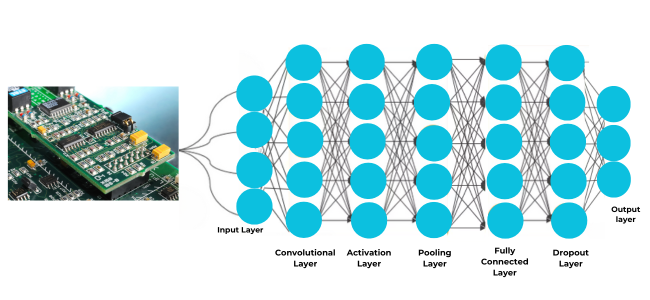What is CNN for image processing?
Published on: Sep 02, 2024

Written by: Admin
Understanding Convolutional Neural Networks (CNNs)
Convolutional Neural Networks (CNNs) are a class of deep learning algorithms primarily used for processing structured grid data such as images. They have proven to be highly effective for tasks like image classification, object detection, and segmentation. CNNs have become a cornerstone in the field of computer vision, powering applications in various domains including healthcare, autonomous driving, and facial recognition.
What is CNN?
A Convolutional Neural Network is a type of artificial neural network designed to recognize patterns in data through hierarchical learning. CNNs are particularly adept at handling image data due to their unique architecture, which consists of several key layers:
- Convolutional Layer: This layer applies a set of filters (also called kernels) to the input image, producing a set of feature maps. Each filter detects a specific feature such as edges, textures, or patterns.
- Activation Layer: Typically, a non-linear activation function like ReLU (Rectified Linear Unit) is applied to introduce non-linearity into the model, allowing it to learn more complex patterns.
- Pooling Layer: This layer performs downsampling (e.g., max pooling or average pooling) to reduce the spatial dimensions of the feature maps, retaining essential information while reducing computational load.
- Fully Connected Layer: These layers are used towards the end of the network to make predictions. They take the flattened feature maps and pass them through one or more dense layers to produce the final output.
- Dropout Layer: To prevent overfitting, dropout layers randomly deactivate a fraction of neurons during training, ensuring the network generalizes well to new data.

How CNNs Work
CNNs process input images through a series of convolutional, activation, and pooling layers to extract hierarchical features. Initially, low-level features like edges are detected, and as the data moves deeper into the network, higher-level features like shapes and objects are recognized. This hierarchical feature extraction makes CNNs highly effective for image-related tasks.
Training a CNN Model
Training a CNN involves several steps, each requiring specific resources and tools. Here’s a comprehensive guide on the resources needed to train a CNN model:
- Data Collection: Gather a large and diverse dataset relevant to the task. For image classification, popular datasets include MNIST, CIFAR-10, and ImageNet. Ensure the dataset is labeled correctly and split into training, validation, and test sets.
- Data Preprocessing: Preprocess the images to ensure consistency and improve model performance. Common preprocessing steps include resizing, normalization, augmentation (e.g., rotation, flipping), and conversion to the appropriate color format.
- Frameworks and Libraries: Use deep learning frameworks like TensorFlow, Keras, or PyTorch to build and train the CNN model. These libraries provide tools and functions to simplify model development and training.
- Hardware: High-performance hardware is essential for training CNNs efficiently. GPUs (Graphics Processing Units) are preferred due to their parallel processing capabilities. Popular options include NVIDIA GPUs with CUDA support.
- Model Architecture: Design the CNN architecture based on the complexity of the task. This involves selecting the number of layers, types of layers, filter sizes, and activation functions. Pre-trained models like VGG, ResNet, and Inception can be fine-tuned for specific tasks to accelerate training and improve performance.
- Training: Train the CNN model using the training dataset. This involves defining a loss function (e.g., cross-entropy for classification), an optimizer (e.g., Adam, SGD), and setting hyperparameters like learning rate, batch size, and number of epochs. Monitor the training process using validation data to prevent overfitting.
- Evaluation: Evaluate the trained model using the test dataset to measure its performance. Common metrics include accuracy, precision, recall, F1-score, and confusion matrix.
- Hyperparameter Tuning: Fine-tune the model by adjusting hyperparameters and retraining. Techniques like grid search, random search, and Bayesian optimization can help find the optimal hyperparameter settings.
- Deployment: Once the model achieves satisfactory performance, deploy it to a production environment. This may involve exporting the model to a format suitable for deployment (e.g., TensorFlow SavedModel, ONNX), integrating it into an application, and setting up monitoring to track its performance in real-world scenarios.
Example of CNN Architecture
Here’s a simple example of a CNN architecture using Keras:
import tensorflow as tf
from tensorflow.keras import layers, models
# Define the CNN model
model = models.Sequential()
model.add(layers.Conv2D(32, (3, 3), activation='relu', input_shape=(64, 64, 3)))
model.add(layers.MaxPooling2D((2, 2)))
model.add(layers.Conv2D(64, (3, 3), activation='relu'))
model.add(layers.MaxPooling2D((2, 2)))
model.add(layers.Conv2D(64, (3, 3), activation='relu'))
# Add fully connected layers
model.add(layers.Flatten())
model.add(layers.Dense(64, activation='relu'))
model.add(layers.Dense(10, activation='softmax'))
# Compile the model
model.compile(optimizer='adam',
loss='sparse_categorical_crossentropy',
metrics=['accuracy'])
# Summary of the model
model.summary()
# Train the model (using a hypothetical dataset)
# model.fit(train_images, train_labels, epochs=10, validation_data=(val_images, val_labels))
Convolutional Neural Networks (CNNs) are a fundamental tool in modern AI, particularly for image processing tasks. By leveraging powerful architectures and vast computational resources, CNNs can achieve remarkable accuracy and efficiency. Understanding the essential components, techniques, and resources for training CNN models is crucial for anyone looking to harness the power of deep learning for computer vision applications. With the right data, tools, and infrastructure, developing robust and effective CNN models becomes a structured and achievable process.

